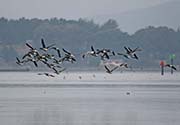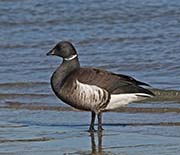Brant Goose - Branta bernicla
| Length | |
| Wingspan | |
| Weight | |
| Clutch Size | |
| Chicks at birth | |
| IUCN Conservation Status | |
Continents: |
The Brant Goose is a small goose that is also known by the name: Brent Goose. There are three subspecies (Dark-bellied Brant Goose, Pale-bellied Brant Goose and Black Brant). Some believe that these subspecies should be considered separate species.
The Black Brant body is mostly black/gray-black/brown-black with white flanks and some white on the belly. The head, neck, bill are black. The breast is also black with a narrow white patch high on either side of the neck (size of patch varies by subspecies). The tail is short and stubby, legs and feet are black and the iris is dark brown. Both sexes are similar but the male is slightly larger. Juveniles are similar but also have white fringes on upperparts and they gradually acquire the white patch on the neck.
Diet: Historically, their diet was most eel-grass and sea lettuce (seaweed) found along the coasts in tidal estuaries. Now they also feed on grass and winter-sown cereals that are a short distance inland. Juveniles also eat insects and invertebrates.
Courtship: Brant Geese have strong permanent pair bonds. Before mating there is mutual head waving and calling.
Nesting: Nest in loose colonies and singly. The nest is built on the ground and is bowl-shaped and lined with grass, moss and down. The eggs are cream, yellowish, greenish or pale olive. The female incubates the eggs while the male defends the nest. Incubation is about 24-26 days and hatching is synchronous.
Habitat and Range: Habitat is coasts, estuaries and sandy shores. Found in the coastal regions of North America, Europe and Asia.
Vocalization: A throat krack
Plumage/Molt: Adults have a complete molt after the chicks are hatched and are flightless for about 30 days. They do not have an alternate plumage.
Migration: Breeds in low-lying wet coastal tundra in the northern hemisphere and migrates in the winter to northwest Europe, East Asia, and the North American Pacific and Atlantic coasts.
Tongue/feet: Black legs and feet.
Bibliography:
- http://en.wikipedia.org The Free Encyclopedia, Accessed January, 2014
- del Hoyo, Josep, Elliott, Andrew, Sargatal, Jordi, et.al., Handbook of the Birds of the World,Lynx Edicions
- Johnsgard, Paul, Ducks, Geese, and Swans of the World,University of Nebraska-Lincoln Press, 1978










